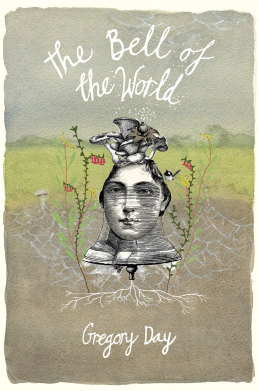This gorgeously evocative Australian novel bursts with a wild energy

“What isn’t in it of life I do not know. The bullock bells, the log and chock fences, the lost chords, the eerie absences … the lingo of the goldfields, the luck of the emu.” So says Uncle Ferny, one of the central characters of Gregory Day’s new novel, The Bell of the World.
It’s Joseph Furphy’s overwhelming Such Is Life of which Ferny speaks, but the words of admiring wonder at such accumulative prowess are as applicable here as there. With this novel, Day covers enormous ground, in a madly taxonomic fashion: mushrooms, music, Melville. All are collected, weighed and placed on the appropriate shelf. Faced with a surfeit – of land and mind, nature and art – Day has responded accordingly. What isn’t in it of life I do not know.
Gregory Day resolutely refuses arcs, throughlines or anything as reductive as a resolution.Credit:Simon O’Dwyer
Uncle Ferny shares the novel with its heart and soul: Sarah Hutchinson, his niece. Having returned home from an Italian jaunt in which Ferny played host and inadvertent matchmaker, Sarah finds herself on a train carving a slow path to Nganghook, the fictional Victorian country town Ferny calls home.
Unlike her other family and very much like her uncle, Sarah is one made of mind, a reader and thinker adrift in her home country. Having once played eager overseas student to Ferny and his cast of cultured bohemians, Sarah will soon enough do the same on home soil, surrounded by a revolving cast of naturalists and other like-minded souls.
The opening pages of Day’s novel are glorious, a gently patient intermingling of memory and landscape. The uncertainty of solitary travel and the way a mind wanders in a slow-moving train carriage are gorgeously evoked. But once we’re settled in Sarah’s new home, the book’s wild energy is set upon the reader.
The Bell of the World by Gregory Day.
Fittingly, it’s the aforementioned Furphy that inspires one of the novel’s key incidents (I am wary of using the term “plot” here, more of which shortly). Making a long trip to “Jones the Bookbinder of Moolap” to refurbish his increasingly shabby copy of Such Is Life, Ferny and Sarah return months later to collect their commission only to discover the request has been honoured and then doubled, with the bookbinder splicing, chapter for chapter, a copy of Melville’s Moby-Dick into the already hefty volume. It’s the perfect symbol for Day’s creative spirit, the too much laid upon the already enough.
So yes: plot, that thing. Books are sliced and trips are made, but the novel feels like anything but a consistent or even dramatically cumulative series of events. There are dalliances, twinned and tripled characters, odd doublings and echoes, and occasional intrusions of both nature (floods) and creation – Sarah’s key musical passion is the prepared piano, placing pieces of flora and fauna on its hammered strings – yet Day resolutely refuses arcs, throughlines or anything as reductive as a resolution.
In the place of the traditional drama, there is philosophy, digression and amusement. Above all else, there is a charting of the inner world, evoked in unashamedly surging, poetic prose.
This is if nothing else a written book, truly made of language and its wild possibilities in a way that shames the tidy grey functional prose of most Australian writers. One short quote barely captures the sustained rhetoric: “Combine dear angels, openly combine. Combine your spirit with your body, mix your body as if in a pestle with the stars. Combine the stars with the land and the body of another.”
For more than 400 pages, Day maintains this flight. It’s the book’s lasting glory and, at times, its biggest problem. The prose on occasions soars in the opposite direction of Day’s characters – their rhetoric and dreaming are grand, but as human presences they can at times feel remote. Like many possessed with a great intellectual curiosity, their passions dwarf them. As Sarah puts it later in the book: “Thus my vocabulary has expanded and I do know a lamella from a squamule, a stem from a stipe.” You never doubt her.
Still, these are bearable problems, and like any great book, it gathers itself magnificently, its final stretch of crosshatched narrative and musical exhilaration among its finest pages. If its middle stretch wanders at times, such is the unapologetic nature of Melvillean amplitude. An editor might have made an unimpeachable masterpiece of it, but betrayed its spirit. With all that surfeit in the world, someone had to do the capturing.
The Bell of the World by Gregory Day is published by Transit Lounge, $32.99.
The Booklist is a weekly newsletter for book lovers from books editor Jason Steger. Get it delivered every Friday.
Most Viewed in Culture
From our partners
Source: Read Full Article

